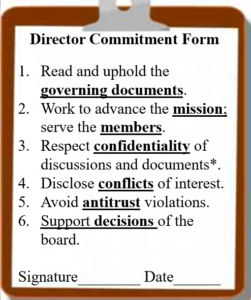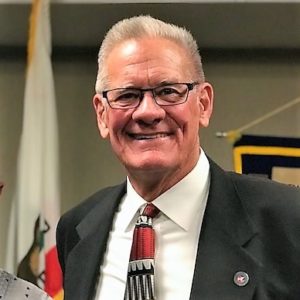It is not unusual to hear a volunteer leader say, “I was told you won’t have to do anything when you get on the board.”
It’s a hoax. Board service is an honor and opportunity. With it comes fiduciary duties to represent member interests, protect and build resources, and advance the mission.
Should board orientation be mandatory? Do board members sign a commitment form?
Familiarization Tour
New directors must understand their roles and governing responsibilities. It starts with organizational familiarization, followed by board orientation and then a commitment to serve.
It is common to brief new directors in a one to one setting about the history, culture, staffing, structure, finances, milestones, and priorities of the organization.
Beyond familiarization with the organization, the entire board should be oriented as a team. It only takes 2 to 3 hours but is critical for all to attend a “refresh and blend” session covering:
- Job Descriptions of Directors and Officers
- Bylaws and Policies
- Performance
- Financial Acumen
- Strategic Direction
- Risk Awareness and Avoidance
Governing documents should be distributed in a leadership notebook, memory-stick, or accessible on-line.
Travis Toliver, IOM, executive director at the Waverly Chamber of Commerce/Main Street said, “Board orientation for new members of our chamber’s leadership team provides an opportunity for them to learn more about their role as a director and to better understand how our organization works and leads the way for businesses in our community.”
Signed Commitment
Following orientation, directors are asked to sign a commitment form.
The form reinforces the duties and is archived in case there was a legal case with a judge asking, “is there any proof you received the documents” or “were you advised to avoid antitrust violations?”
“Our board has an annual retreat to discuss roles and responsibilities. At the end of the meeting directors sign for receipt of the governing documents and their understanding of items like disclosing conflicts and avoiding antitrust violations,” said Steven Beazley, CEO, Wyoming REALTORS®.

Keep the form simple for ease of understanding, avoiding legalese. This example covers six areas.
- Governing Documents – Acknowledges documents were received and will be read.
- Mission Statement – Understanding the role of directors is to advance the mission.
- Confidentiality – Directors recognize they don’t speak for the board or organization. There are lines of communication to respect.
- Conflicts of Interest – Conflicts will be disclosed at least annually and at any meeting in which a potential conflict appears on the agenda.
- Antitrust – The FTC urges that associations have a measure in place to avoid antitrust violations.
- Unanimity – Decisions made at the board meeting will be supported by all directors, no matter the dissent or positions expressed during the meeting.
In summary, volunteer leaders benefit from familiarization, orientation, receiving the governing documents and signing a commitment form.
At the close of orientation, the final thought might be, “Don’t plan to just sit on the board, plan to serve on the board.”
# # #
Note: David Aaker, IOM, is on the faculty for the US Chamber Foundation’s Institute for Organization Management, teaching courses on management, leadership, customer service and ethics. His website: www.davidkaaker.com. Bob Harris, CAE, provides free governance tips and templates at www.nonprofitcenter.com.
A great honor to collaborate on association and chamber excellence with David Aaker, IOM, ACE.
Email bob@rchcae.com with any questions, ideas or examples.
can you email any sample forms?